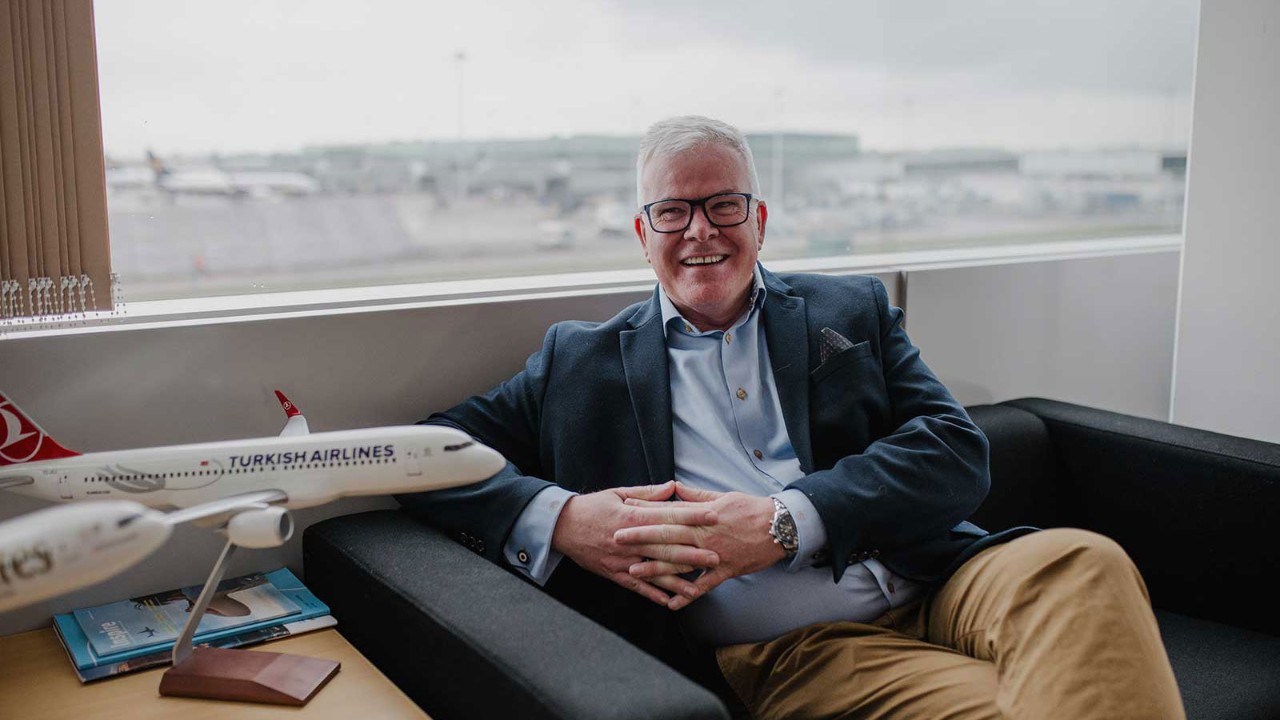
As plans for a third runway at Heathrow Airport (see AB coverage) hog the headlines, a quieter evolution is underway 40 miles or so north-east of the capital.
Stansted Airport, part of the Manchester Airport Group, is part way through a £1.1bn transformation that will see annual passenger numbers increase from the current 30 million to almost 42 million, all from its existing single runway and a lone terminal. Building works are already in hand to expand the terminal – while millions of passengers continue to pass through it every month.
‘It’s a tricky time, but this is the pain before the gain’
Matt Dolphin FCCA, Stansted’s FD, says: ‘It’s like Christmas Day and you’ve invited all the family around and in the middle of it someone says, “Let’s knock that wall down and build an extension.” You can’t close the airport for two years – that’s not going to happen. So here we are. It’s a tricky time, but this is the pain before the gain.’
The five-year redevelopment will see the terminal rebuilt out to hold a larger departure lounge with more hospitality facilities and a new layout for security, along with some changes to the airfield infrastructure and the use of land within its existing boundary. With the extra runway for the south-east of England recommended by the Airports Commission in 2012 earmarked for Heathrow, Stansted is committed to ‘making the most efficient use of what we have’.
Well situated
‘What we have’ has already made Stansted one of the fastest-growing airports in the UK since its Norman Foster-designed terminal opened in 1991. There are 25 million people living within a two-hour drive of the airport, and it has good road and direct rail links from London. Its position within the UK Innovation Corridor and proximity to the Oxford-Cambridge Growth Corridor bodes well for the future.
In 2021, permission was granted for Stansted to increase its passenger numbers to 43 million a year, on up to 274,000 flights (this compares with 480,000 flights per year currently at Heathrow). It is also the country’s third-largest cargo airport, handling 307,000 tonnes a year.
Grand plans
Even so, Stansted’s passenger numbers are set to soar. The key is larger planes, and the decision by Ryanair, which accounts for 75% of the airport’s business, and other short-haul carriers to invest in larger aircraft.
‘Ryanair already has long-term orders in for bigger aircraft, and that will drive up our passenger numbers,’ Dolphin says. ‘We need to be ready for that.’ In theory, larger aircraft mean that between 48 and 51 million passengers a year could be carried by 2040 without exceeding Stansted’s flights cap, although it would need permission to increase annual passenger numbers beyond 43 million.
‘With so many passengers in the airport it’s quickly noticeable if something goes wrong’

Stansted’s single runway is a long one – it is one of the few UK airports that can land an Airbus A380 – but coping with millions of extra passengers moving through a single terminal takes serious planning.
‘If we get to 50 million passengers, that would make us probably the busiest single-runway, single-terminal airport in Europe,’ Dolphin says. ‘We need to think about what needs to happen to the road and rail infrastructure serving the airport, how much parking we will need, how it will all work. It’s all about efficiency of movement, getting volumes of people through the single building effectively.’
Dolphin’s focus has been on ‘small, incremental gains’ wherever they can be made. ‘How do we make the drop-off zone more efficient, for example? We remove the barriers and use automatic number plate recognition. It’s a saving of 20 seconds for a driver, but that’s 500 cars a day. We’re also making use of a lot of technology in terms of managing people flows.’
Business first
Dolphin has extensive experience of transport, having held senior positions in FirstGroup, Go-Ahead, BA and Arriva, and was FD at Greater Anglia (see AB interview) during the Covid years. He knows that balancing cost management and operational resilience is key for finance professionals in the sector.
‘I’m very much a business partner. If you were narrow-minded you might try to clamp down on overtime, for example, but there is always a trade-off between cost and operations. No one wants to see a queue out of the terminal door because there are not enough people on security. There are so many passengers in the airport that it very quickly becomes noticeable when something goes wrong – and it’s also likely to make headline news.’
‘Airports are a whole other world. They are fascinating’
He is clearly relishing the challenge at Stansted. ‘This a big infrastructure programme – just name all of those that have come in on time and under budget! So that’s at the top of my agenda.’
Net zero
Sustainability, too, is a priority and featured prominently in the consultation on Stansted’s development plan, which closed in March this year. A key aim is to bring carbon emissions from the airport’s operational activities down to net zero by 2038.
‘We take our sustainability targets very seriously,’ Dolphin says. A solar farm will form part of the current development, and the airport is working with its airline partners to move towards sustainable aviation fuel. Transport to and from the airport is also critical; more than half of passengers arrive on public transport.
He adds: ‘We have targets for fewer road movements. If someone drops you off at the airport, that’s four journeys instead of two. The train would be even better.’
Dolphin’s enthusiasm for Stansted, and for the intricacies of transport, are clear. ‘Transport and moving people from A to B runs through my blood,’ he says. ‘But airports are a whole other world. They are fascinating. That’s one of the great things about the aviation sector – it’s exciting and dynamic. And I’m around that every day.’
CV
2024
FD, Stansted Airport
2022
Commercial FD, Great British Railways Transition Team
2018
FD, Greater Anglia
2016
Interim FD roles
2012
Various roles at British Airways, including FD of Gatwick
2006
FD, Go South Coast
1999
Various roles at First Group, including FD of First Essex Buses



